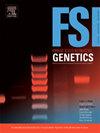用y - str评价RMplex系统在韩国人群中区分父子对的作用。
IF 3.1
2区 医学
Q2 GENETICS & HEREDITY
引用次数: 0
摘要
快速突变(RM)位点上的y染色体短串联重复序列(Y-STRs)被认为是区分父系相关男性的工具。RMplex是最近开发的一种系统,包含26个RM位点和4个快速突变(FM)位点,靶向44个男性特异性位点。在这里,我们通过估算542对韩国父子对的Y-STR突变率和总体分化率,以及409对无亲缘关系男性的遗传群体值来评估RMplex。RMplex表现良好,通过至少一个突变区分50.7% %的父子对,比先前报道的使用PowerPlex®Y23系统实现的分化率高10倍。在369个突变中,361个(97.8 %)为单步突变,位点特异性突变率为每代1.8 × 10-3 ~ 1.1 × 10-1,平均突变率为2.3 × 10-2。DYS442的基因多样性值为0.5696 ~ 0.9970,无亲缘关系雄性的单倍型辨别能力为100 %。在研究的位点中,DYS712在韩国人群中表现出最高的突变率。同样,据报道,该位点的突变率在日本和中国人群中比在欧洲人群中高得多。这些发现表明DYS712突变在东亚人群中相对常见。虽然我们没有发现基于y染色体单核苷酸多态性的单倍群之间的显著关系,但等位基因长度与DYS712的突变率密切相关,这与以往的研究一致。尽管将多拷贝基因座整合到RMplex中显著提高了检测到的高突变率和其辨别能力,但由于可能存在重复,这需要仔细解释。尽管如此,这些发现为RMplex在韩国人群中区分父系相关男性的适用性提供了证据。本文章由计算机程序翻译,如有差异,请以英文原文为准。
Evaluation of RMplex system for differentiating father–son pairs using Y-STRs in a Korean population
Y-chromosomal short tandem repeats (Y-STRs) at rapidly mutating (RM) loci have been suggested as tools for differentiating paternally related males. RMplex is a recently developed system that incorporates 26 RM loci and four fast-mutating (FM) loci, targeting 44 male-specific loci. Here, we evaluated the RMplex by estimating Y-STR mutation rates and the overall differentiation rates for 542 Korean father–son pairs, as well as the genetic population values for 409 unrelated males. RMplex performed well, distinguishing 50.7 % of the father–son pairs by at least one mutation, a value 10 times higher than the previously reported differentiation rate achieved using the PowerPlex® Y23 System. Of the 369 mutations, 361 (97.8 %) were single-step mutations, with locus-specific mutation rates varying from 1.8 × 10−3 to 1.1 × 10−1 mutations per generation, and an average mutation rate of 2.3 × 10−2. Gene diversity values ranged from 0.5696 for DYS442 to 0.9970 for DYF1000, and the haplotype discrimination capacity of unrelated males was 100 %. Among the loci studied, DYS712 exhibited the highest mutation rate in this study of the Korean population. Similarly, the mutation rate of this locus is reported to be substantially higher for the Japanese and Chinese populations than for European populations. These findings suggest that DYS712 mutations are relatively frequent in East Asian populations. Although we did not detect significant relationships among the Y-chromosome single nucleotide polymorphism-based haplogroups, allele length was strongly correlated with the mutation rate at DYS712, which is consistent with previous studies. Although the incorporation of multi-copy loci into RMplex contributed significantly to the high mutation rates detected and to its discrimination capacity, this requires careful interpretation, owing to the potential for duplications. Nonetheless, these findings provide evidence regarding the suitability of the RMplex for distinguishing paternally related males in the Korean population.
求助全文
通过发布文献求助,成功后即可免费获取论文全文。
去求助
来源期刊
CiteScore
7.50
自引率
32.30%
发文量
132
审稿时长
11.3 weeks
期刊介绍:
Forensic Science International: Genetics is the premier journal in the field of Forensic Genetics. This branch of Forensic Science can be defined as the application of genetics to human and non-human material (in the sense of a science with the purpose of studying inherited characteristics for the analysis of inter- and intra-specific variations in populations) for the resolution of legal conflicts.
The scope of the journal includes:
Forensic applications of human polymorphism.
Testing of paternity and other family relationships, immigration cases, typing of biological stains and tissues from criminal casework, identification of human remains by DNA testing methodologies.
Description of human polymorphisms of forensic interest, with special interest in DNA polymorphisms.
Autosomal DNA polymorphisms, mini- and microsatellites (or short tandem repeats, STRs), single nucleotide polymorphisms (SNPs), X and Y chromosome polymorphisms, mtDNA polymorphisms, and any other type of DNA variation with potential forensic applications.
Non-human DNA polymorphisms for crime scene investigation.
Population genetics of human polymorphisms of forensic interest.
Population data, especially from DNA polymorphisms of interest for the solution of forensic problems.
DNA typing methodologies and strategies.
Biostatistical methods in forensic genetics.
Evaluation of DNA evidence in forensic problems (such as paternity or immigration cases, criminal casework, identification), classical and new statistical approaches.
Standards in forensic genetics.
Recommendations of regulatory bodies concerning methods, markers, interpretation or strategies or proposals for procedural or technical standards.
Quality control.
Quality control and quality assurance strategies, proficiency testing for DNA typing methodologies.
Criminal DNA databases.
Technical, legal and statistical issues.
General ethical and legal issues related to forensic genetics.

 求助内容:
求助内容: 应助结果提醒方式:
应助结果提醒方式:


